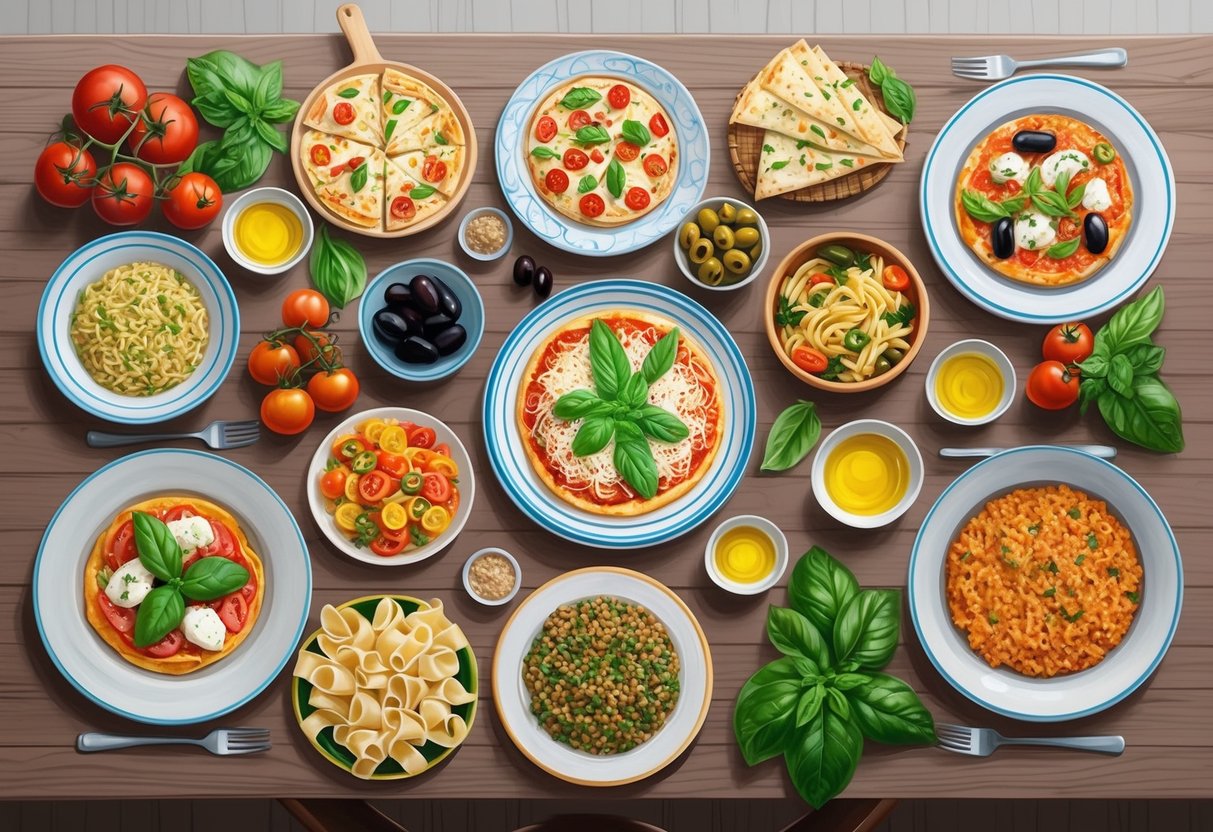
Italian cuisine stands out for its regional diversity and timeless recipes that have won hearts worldwide. Exploring classic Italian foods reveals a rich tradition of fresh ingredients, simple techniques, and unforgettable flavors that are easy for anyone to enjoy at home.
From creamy risottos to savory ragu and hand-tossed pizza, each dish reflects the unique history and culture of Italy’s many regions.
Readers searching for an introduction to essential Italian dishes will discover not only favorites like cacio e pepe, pizza Napoletana, and risotto Milanese, but also lesser-known specialties deeply rooted in local tradition.
These classic recipes and cooking styles offer insight into why Italian food remains one of the most beloved global cuisines, presenting both familiar comfort and new taste experiences.
Those eager to learn more about authentic dishes and ingredients can find inspiration in thoughtfully curated lists of traditional Italian recipes.
By understanding the core components of Italian cuisine—olive oil, tomatoes, basil, artisan cheeses, and handmade pasta—anyone can begin recreating these iconic meals.
Whether you’re planning your next dinner or ready to master the art of Italian cooking, the world of Italian food invites both home cooks and enthusiasts to experience genuine culinary joy.
Essentials of Classic Italian Cuisine
Classic Italian cuisine emphasizes fresh ingredients, simple methods, and harmonious flavors.
Standards such as olive oil, garlic, and seasonal vegetables set the foundation for authentic regional recipes and a traditional Mediterranean diet.
Foundational Ingredients
The backbone of Italian cooking rests on a short list of high-quality staples.
Extra-virgin olive oil is used both for cooking and as a finishing touch, offering depth and fruitiness to countless dishes.
Garlic is another pillar—often sautéed with olive oil as a first step in sauces, soups, and sautés.
Fresh herbs, especially oregano and basil, provide brightness and aroma.
Tomatoes—either fresh or canned—form the core of many pasta sauces.
Balsamic vinegar, mostly from Modena, is used for dressings, marinades, and sometimes even desserts, giving dishes a subtle sweetness and tang.
Fresh vegetables, artisanal cheese, and specialty grains like arborio rice or dried durum wheat pasta ensure variety and nutrition.
Short ingredient lists place the focus on food quality.
Italian cooks often visit local markets to select the best produce each day, keeping meals in tune with the seasons and regionally distinctive.
Core Cooking Techniques
Italian cooking relies on accessible methods designed to highlight, not overshadow, the ingredients.
Soffritto, a sauté of finely chopped onion, garlic, parsley, and sometimes celery or carrot, serves as the aromatic base of countless recipes.
Slowly sweating vegetables draws out their sweetness and sets a rich foundation.
Insaporire, the practice of simmering ingredients together so flavors meld, is central to perfecting sauces and stews.
Pasta is boiled until just al dente, then finished in the sauce to absorb flavor.
Roasting and grilling highlight meats, fish, and vegetables, producing deeply savory and caramelized dishes.
Traditional skills emphasize timing and balance over complexity.
Italian cooking is about extracting the most from foundational ingredients while preserving texture and freshness.
Flavor Profiles and Seasonality
Italian flavor profiles showcase a balance of savory, herbal, and sometimes gently sweet notes.
Olive oil delivers peppery richness, garlic and herbs like oregano layer in fragrance, and fresh produce brings sweetness and acidity.
Balsamic vinegar adds depth and mild sharpness, especially in salads and glazes.
Dishes are tuned to seasonal changes: tomatoes and basil in summer, mushrooms and hearty greens in winter.
The Mediterranean diet’s reliance on fresh, unprocessed foods helps maintain vibrant flavors and nutrients.
Seasonality not only dictates which vegetables and herbs are used, it influences the complexity—cool months favoring slow-cooked dishes, warmer months lighter fare.
Consistency in using in-season, regional ingredients ensures each recipe is at its peak.
This approach yields Italian cuisine that is straightforward, healthful, and undeniably flavorful, as detailed in the acclaimed cookbook Essentials of Classic Italian Cooking.
Traditional Italian Pasta Dishes
Italy’s pasta landscape offers a wealth of textures, shapes, and flavors.
From time-honored dried spaghetti to delicate fresh tortellini, each variety of pasta is typically paired with sauces designed to complement its unique character.
Spaghetti and Pasta Varieties
Italian cuisine features an extensive array of pasta types, each with its own essential role in traditional recipes.
Spaghetti, a long, thin noodle, often takes center stage in well-known dishes like carbonara and aglio e olio.
Tubular shapes, such as bucatini, feature a hollow center that helps soak up rich sauces.
Wider noodles like pappardelle are ideal for heartier meat sauces, while stuffed pastas such as tortellini are cherished in northern regions for their refined fillings.
Italians typically cook pasta “al dente,” ensuring a firm bite that enhances flavor and texture.
Many classic Italian recipes rely on choosing the right pasta for each sauce, and some shapes are tied closely to specific regions or cities.
For a deeper look at Italy’s beloved pasta shapes and their classic uses, browse the guide for classic Italian pasta recipes.
Fresh vs. Dried Pasta
Fresh and dried pastas differ significantly in texture, taste, and traditional use.
Fresh pasta tends to be soft and tender, crafted from flour and eggs, making it well suited for delicate preparations like ravioli or tagliatelle with cream-based sauces.
Dried pasta—made from semolina flour and water—holds its shape better in boiling water and pairs well with robust sauces such as amatriciana or puttanesca.
Most types of spaghetti and bucatini are traditionally available in dried form, offering convenience and a slightly firmer texture.
Cooks often select between fresh and dried types based on both the sauce and regional traditions.
Northern Italians typically favor fresh egg pasta, while southern regions prefer dried varieties due to the climate and local wheat.
Popular Pasta Sauces
Classic Italian pasta dishes are defined not just by the noodles, but by their iconic sauces.
Carbonara combines eggs, Pecorino Romano cheese, guanciale, and black pepper, resulting in a creamy, savory coating for spaghetti or bucatini.
Pesto Genovese, made with fresh basil, pine nuts, garlic, Parmesan, and olive oil, finds its perfect pairing with trenette or trofie.
Tomato-based sauces like pomodoro and amatriciana highlight the bright flavors of ripe tomatoes, while complex fish sauces appear often along the coast.
Each sauce is balanced to complement specific pasta shapes, a tradition rooted in generations of culinary practice.
For inspiration, explore a list of traditional Italian pasta dishes that showcase classic pairings and bold flavors.



